Diffusion Characteristics and Mechanisms of Thermal Plumes from Coastal Power Plants: A Numerical Simulation Study
Abstract
1. Introduction
2. Description of Study Area and Thermal Discharge
3. Model Configuration and Verification
4. Analysis of Thermal Plume Characteristics
4.1. Flow Field near Wushashan Power Plant
4.2. Dispersion Characteristics of Thermal Plume during Calm Weather and Typhoons
4.2.1. Analysis of Thermal Plume Characteristics
4.2.2. Analysis of Thermal Plume Mechanism
4.3. Dispersion Characteristics and Mechanisms of Thermal Plume during Typhoon
4.3.1. Analysis of Thermal Plume Characteristics
4.3.2. Analysis of Thermal Plume Mechanism
5. Discussion
6. Conclusions
Author Contributions
Funding
Institutional Review Board Statement
Informed Consent Statement
Data Availability Statement
Conflicts of Interest
References
- Miao, Q.; Zhou, L.M.; Deng, Z.Q. Measurement and numerical simulation of thermal discharge from Xiangshan Port power plant. Coast. Eng. 2010, 29, 1–11. [Google Scholar]
- Zhang, C.L.; Liang, C.L.; Zhang, J.Y.; Shi, H.G. Remote sensing monitoring of thermal discharge from Tianwan Nuclear Power Station based on Landsat-8 TIRS data. Geospat. Inf. 2019, 17, 70–72, 87. [Google Scholar] [CrossRef]
- Zhang, W.Q.; Zhou, R.M. Thermal impact analysis of Daya Bay Nuclear Power Station and Ling’ao Nuclear Power Station effluent discharge. Radiat. Prot. 2004, 24, 257–262. [Google Scholar]
- Wang, G.L.; Xiong, X.J. Analysis of thermal discharge distribution and variations in the Tianwan Sea area. Adv. Mar. Sci. 2013, 31, 69–74. [Google Scholar]
- Zhao, Q.; Cao, W.; Xing, J.; Long, S.Q. Analysis of spatial and temporal characteristics of winter thermal discharge in Sanmen Nuclear Power Plant based on field observation data. Mar. Environ. Sci. 2022, 41, 847–856. [Google Scholar] [CrossRef]
- Bush, R.M.; Welch, E.B.; Mar, B.W. Potential effects of thermal discharges on aquatic systems. Environ. Sci. Technol. 1974, 8, 561–568. [Google Scholar] [CrossRef]
- Jiang, W.; Lin, Y.J.; Lu, Y.H. Experimental research method and application of cooling water project in tidal river channels. J. Guangzhou Univ. (Nat. Sci. Ed.) 2001, 15, 43–47. [Google Scholar]
- Yang, H.Y. Experimental study on thermal discharge influenced by tidal flow. Guizhou Water Power 2005, 19, 75–78. [Google Scholar]
- Wang, Y.; Luo, A.; Lu, H.Z. Physical model test on thermal discharge of new construction project of Lufeng Jiahuwan Power Plant. Guangdong Water Conserv. Hydropower 2015, 1–5. [Google Scholar]
- Liang, H.H.; Kang, Z.S. Physical model test of thermal discharge in the second phase of Hongyanhe nuclear power plant. In Proceedings of the Thesis of the 6th National Conference on Hydraulics and Water Informatics, Beijing, China, 8 June 2013; pp. 82–88. [Google Scholar]
- Tang, D.L.; Kester, D.R.; Wang, Z.d.; Lian, J.S.; Kawamura, H. AVHRR satellite remote sensing and shipboard measurements of the thermal plume from the Daya Bay nuclear power station, China. Remote Sens. Environ. 2003, 84, 506–515. [Google Scholar] [CrossRef]
- Qin, Z.H.; Li, W.J.; Zhang, M.H.; Arnon, K.; Pedro, B. Estimation method of atmospheric parameters based on single-window algorithm. Remote Sens. Land Resour. 2003, 37–43. [Google Scholar] [CrossRef]
- Xu, H.P.; Ma, Y.; Zhao, X.S. Application research of Landsat-8 satellite imagery in thermal discharge monitoring of nuclear power plants. In Proceedings of the 6th Annual Conference of the China Risk Assessment Committee on Information Technology in Risk Analysis and Crisis Response, Hohhot, Inner Mongolia, China, 23 August 2014; pp. 836–839. [Google Scholar]
- Gu, H.Q.; Zou, G.L.; Ma, J.R. Application of Landsat-8 TIRS data in thermal discharge monitoring of a nuclear power plant. Mar. Sci. 2016, 40, 76–81. [Google Scholar]
- Xu, J.; Zhu, L.; Jiang, J.; Li, J.G.; Zhao, S.H.; Yuan, L. Remote sensing monitoring of thermal discharge from Daya Bay Nuclear Power Base based on HJ-1B and TM thermal infrared data. Environ. Sci. China 2014, 34, 1181–1186. [Google Scholar]
- Yang, H.Y.; Zhu, L.; Wu, C.Q.; Jia, X.; Zhao, H. Remote sensing monitoring and environmental impact analysis of thermal discharge from nuclear power plants. Environ. Prot. 2018, 46, 18–22. [Google Scholar] [CrossRef]
- Huang, X.Q.; Ye, S.F. Monitoring and Impact Assessment of Thermal Discharge from Xiangshan Port Power Plant; Ocean Press: North Melbourne, VIC, Australia, 2014. [Google Scholar]
- Xia, Y.Y.; Liu, Z.M.; Cui, Y.S.; Mou, W.T.; Lv, H.B. Spatiotemporal characteristics of thermal discharge from Sheyang Port power plant based on Landsat data. J. Jiangsu Ocean Univ. (Nat. Sci. Ed.) 2022, 31, 42–48. [Google Scholar]
- Lin, J.; Zhang, S.Y.; Gong, F.X. Numerical simulation study on site selection evaluation of marine ranching planning area of Xiangshan Port: Influence of thermal discharge from coastal power plants. J. Shanghai Ocean Univ. 2012, 21, 816–824. [Google Scholar]
- Chen, Z.J.; Zeng, Z.; Chen, C.H.; Tang, J.J. Study on plane distribution and vertical variation of temperature rise under the influence of thermal discharge from coastal power plants: A case study of Kemen Power Plant in Luoyuan Bay. Mar. Environ. Sci. 2023, 42, 111–121. [Google Scholar]
- Chen, H. Research on Mathematical Models of Thermal Discharge from Houshi Power Plant; Xiamen University: Xiamen, China, 2002. [Google Scholar]
- Liu, H.C.; Chen, H.B. Application of unstructured grid in the numerical model of thermal discharge from Yacheng Power Plant in Indonesia. Waterw. Port 2009, 30, 316–319. [Google Scholar]
- Sun, X.M.; Zhang, L.G. Prediction method and application of thermal pollution in thermal power plants. Environ. Prot. Circ. Econ. 2001, 21, 30–31. [Google Scholar]
- Zhang, J.M.; Wu, S.Q.; Wang, H.M. Analysis of flow characteristics and research on model parameters in thermal discharge areas of power plants. Northeast Water Conserv. Hydropower 2005, 23, 51–52. [Google Scholar]
- Duan, Y.F.; Zhao, Y.J.; Ji, P.; Zhang, B.B. Comparison between water tank test and numerical simulation of thermal discharge and the distribution of water temperature. J. Hydroelectr. Eng. 2017, 36, 100–110. [Google Scholar]
- Yanagi, T.; Sugimatsu, K.; Shibaki, H.; Shin, H.; Kim, H. Effect of tidal flat on the thermal effluent dispersion from a power plant. J. Geophys. Res. 2005, 110, 1–15. [Google Scholar] [CrossRef]
- Zhang, G.J. Study on Three-Dimensional Numerical Simulation of Thermal Discharge in the Northern Longkou Sea Area; First Institute of Oceanography, State Oceanic Administration: Qingdao, China, 2015. [Google Scholar] [CrossRef]
- Gu, J.; Han, X.J.; Kuang, C.P.; Zhang, J.Y.; Zuo, L.L.; Zhu, Q. Three-dimensional simulation and analysis of thermal discharge transport in estuaries, lagoons, and coastal areas. J. Hydrodyn. Ser. A 2020, 35, 201–212. [Google Scholar]
- You, Z.J.; Jiao, H.F. Ecological Environment Protection and Restoration Techniques in Xiangshan Port; Ocean Press: London, UK, 2011. [Google Scholar]
- Chen, C.S.; Beardsley, R.C.; Cowles, G. An Unstructured Grid, Finite-Volume Coastal Ocean Model: FVCOM User Manual; Smast/Umassd: Boston, MA, USA, 2006. [Google Scholar]
- Pawlowicz, R.; Beardsley, B.; Lentz, S. Classical tidal harmonic analysis including error estimates in MATLAB using T_TIDE. Comput. Geosci. 2002, 28, 929–937. [Google Scholar] [CrossRef]
- Ye, T.Y. Multi-Temporal and Spatial Scale Dynamics of Suspended Sediment in Hangzhou Bay and the Feedback Mechanism with Tidal Flat Changes; Zhejiang University: Hangzhou, China, 2019. [Google Scholar]
- Kong, G.Q.; Li, L.; Guan, W.B. Influences of tidal flat and thermal discharge on heat dynamics in Xiangshan Bay. Front. Mar. Sci. 2022, 9, 1–17. [Google Scholar] [CrossRef]
- Monismith, S.G. Contemporary Issues in Estuarine Physics: Mixing in Estuaries; Cambridge University: Cambridge, UK, 2010; pp. 145–185. [Google Scholar]
- Geyer, W.R.; Maccready, P. The estuarine circulation. Annu. Rev. Fluid Mech. 2014, 46, 299–305. [Google Scholar] [CrossRef]
- Bigg, P.H. Density of water in SI units over the range 0–40 °C. Br. J. Appl. Phys. 2002, 18, 521–525. [Google Scholar] [CrossRef]
- Yao, Y.M.; Zheng, Y.Q.; Zhao, X.Y.; Yuan, J.X.; Li, L. Characteristics of stratification in the Jiaojiang Estuary. Haiyang Xuebao 2021, 43, 23–37. [Google Scholar]
- Miles, J.W. On the stability of heterogeneous shear flows. J. Fluid Mech. 1961, 10, 496–508. [Google Scholar] [CrossRef]
- Fu, D.T.; Xie, C.C.; Wu, J.B.; Wei, Y.L. Water stability and its influencing factors in the adjacent waters of the Yangtze River Estuary. J. Xiamen Univ. (Nat. Sci. Ed.) 2020, 59, 39–45. [Google Scholar] [CrossRef]
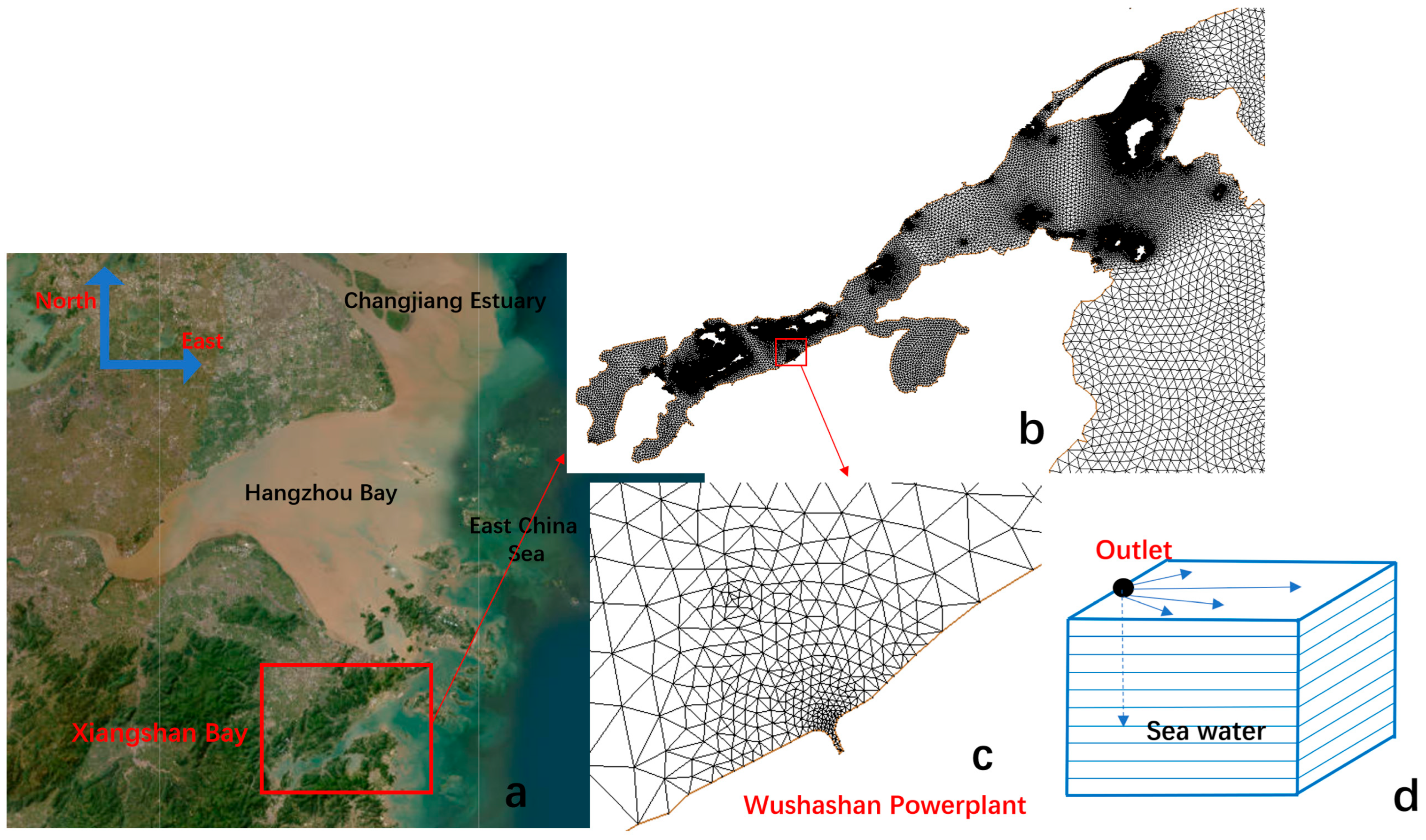
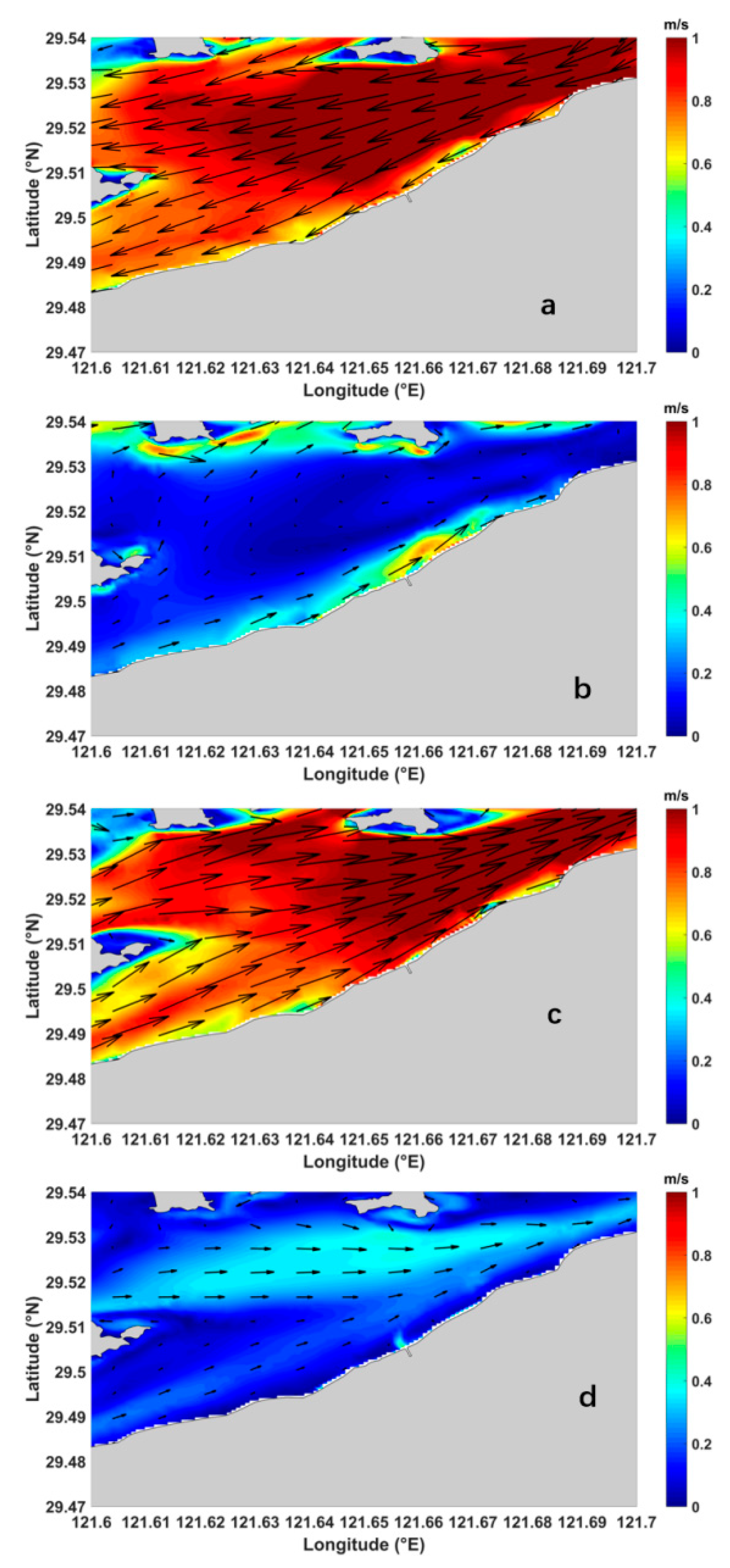

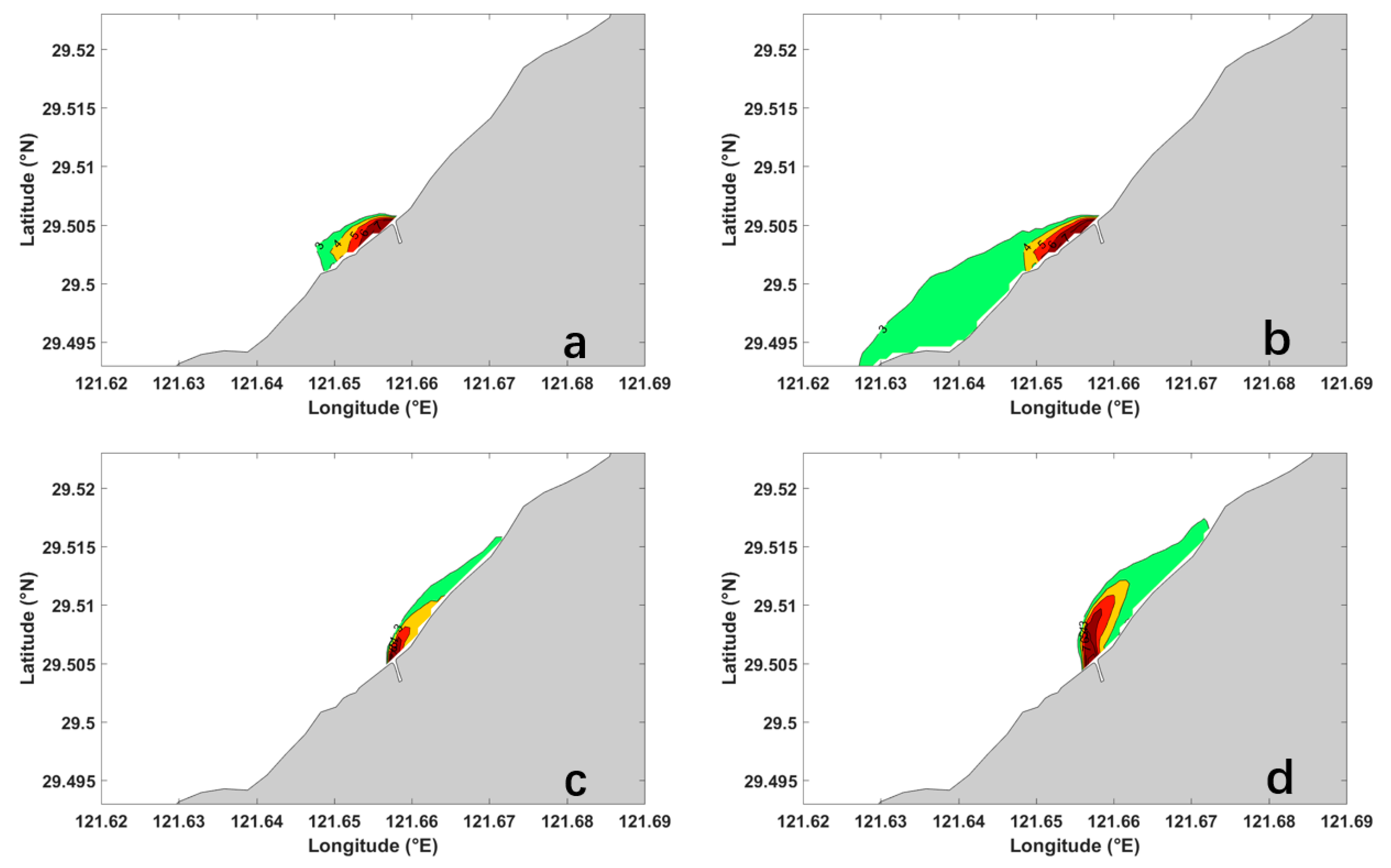
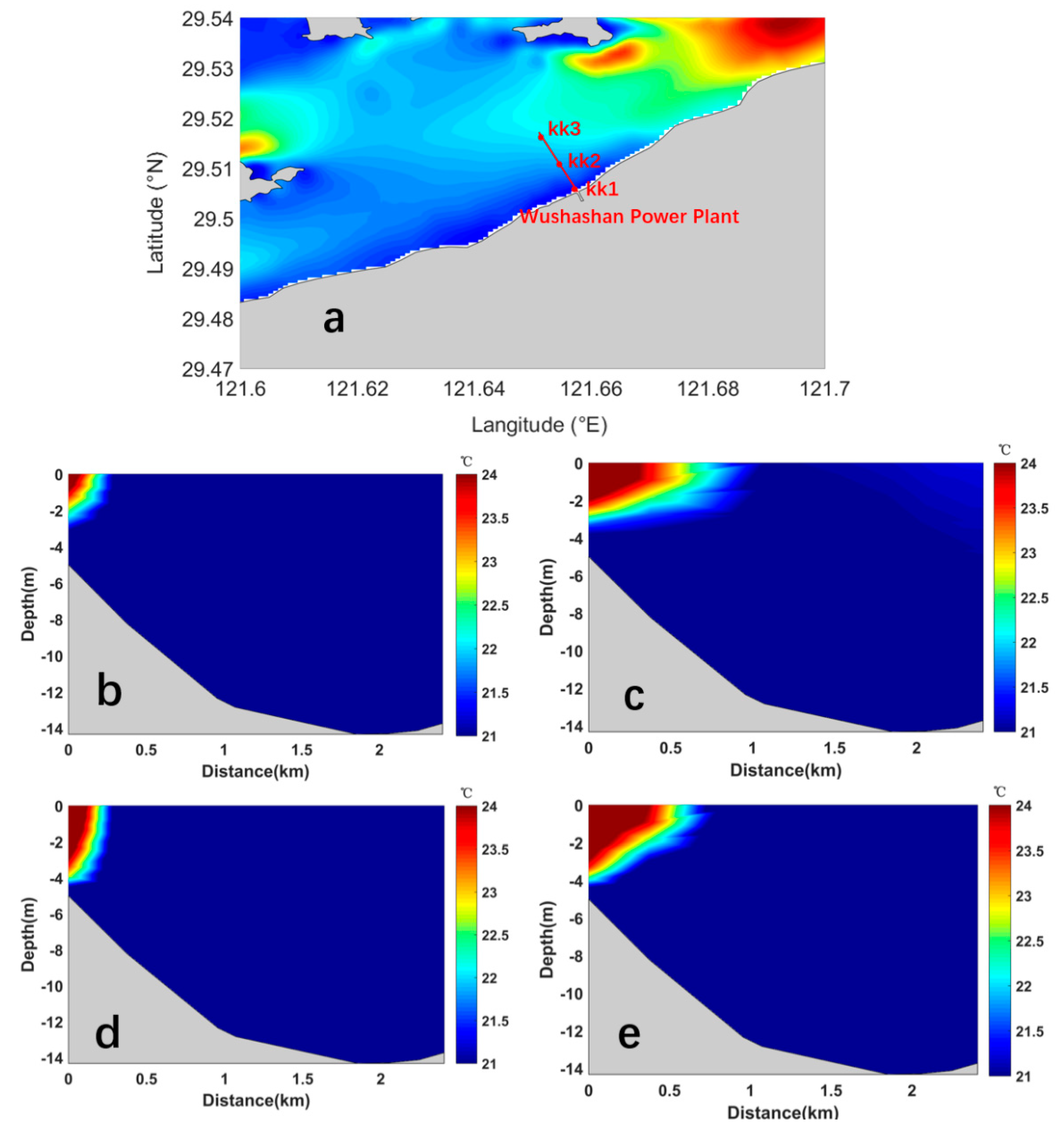
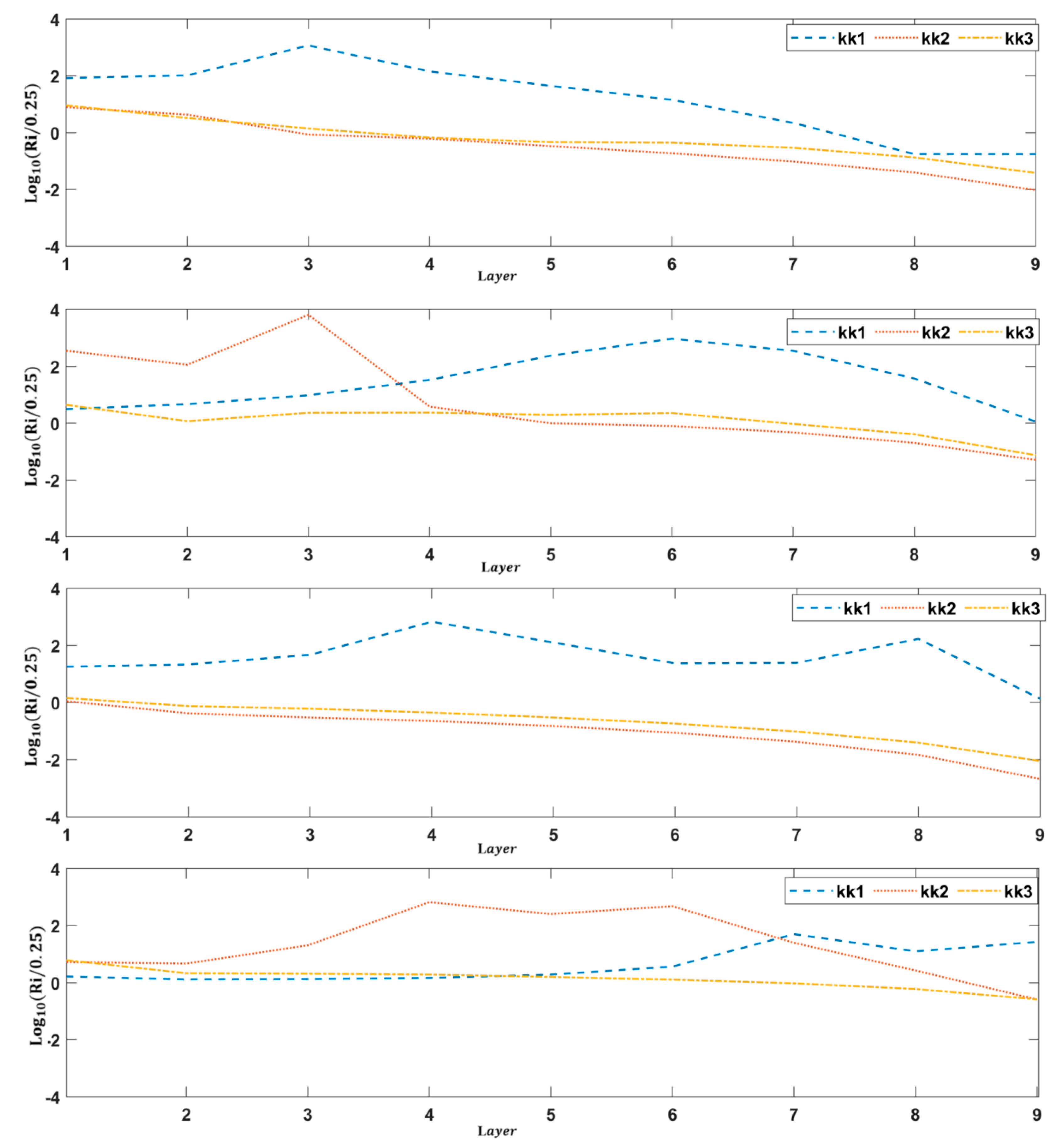

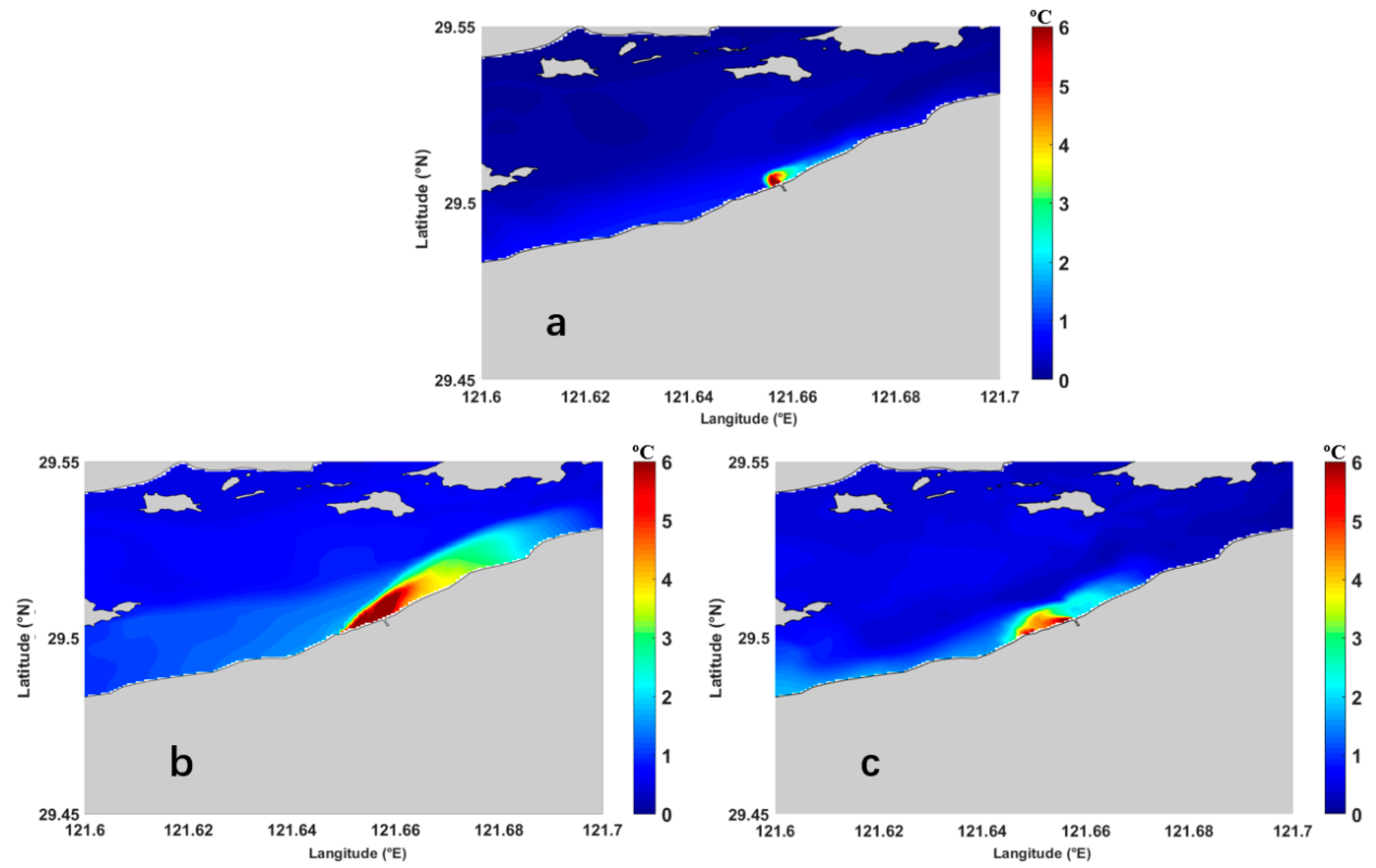

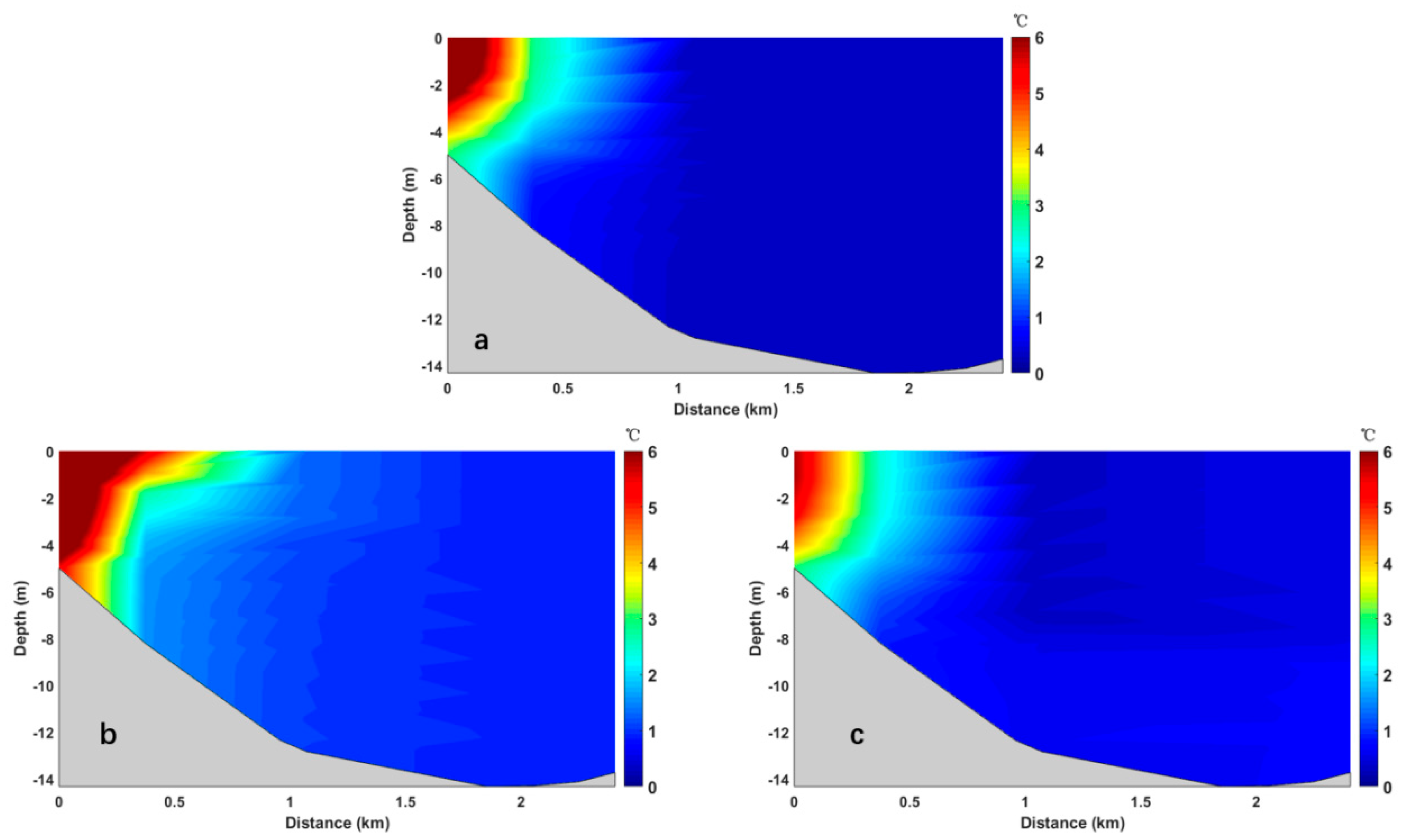
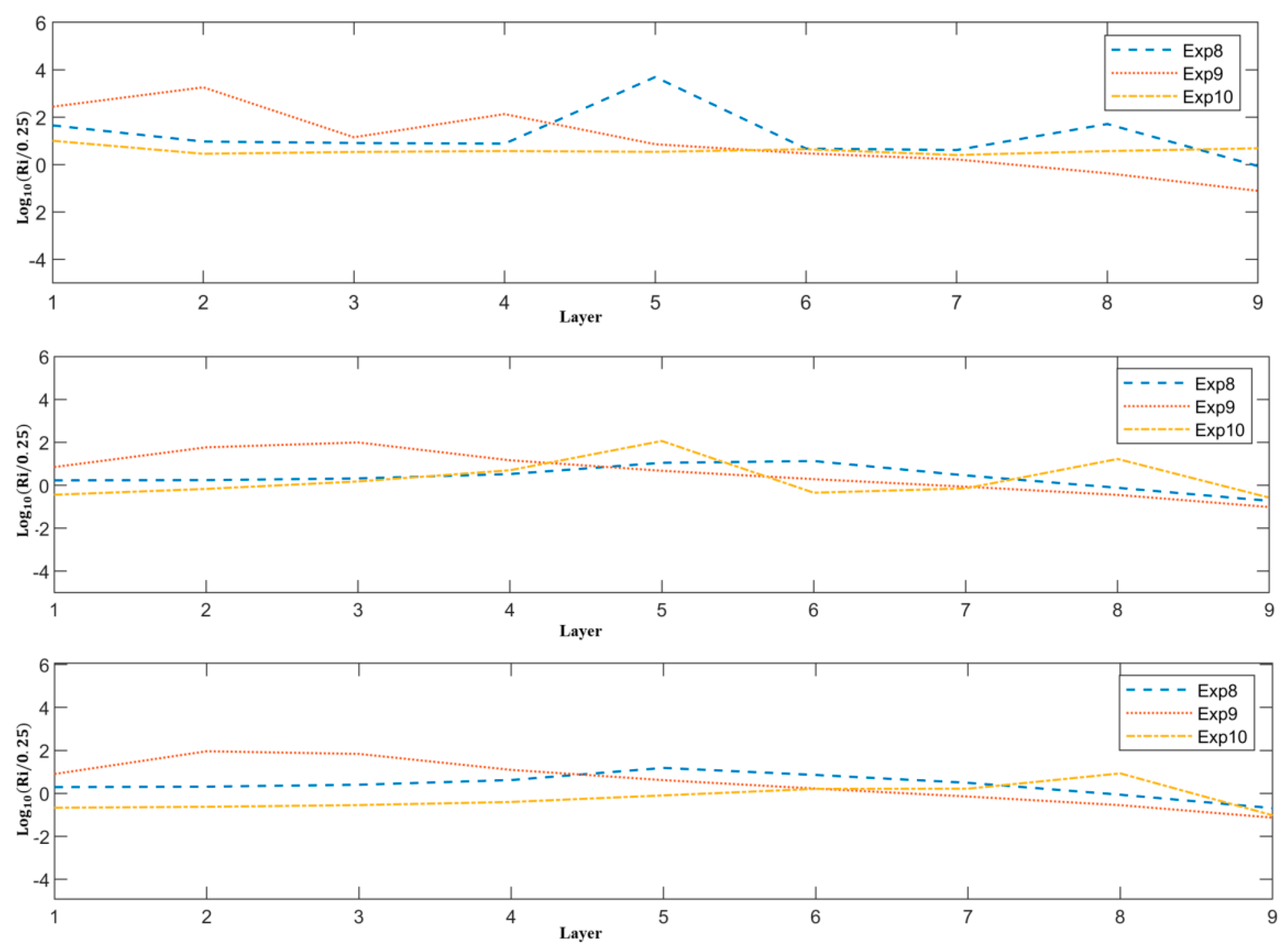
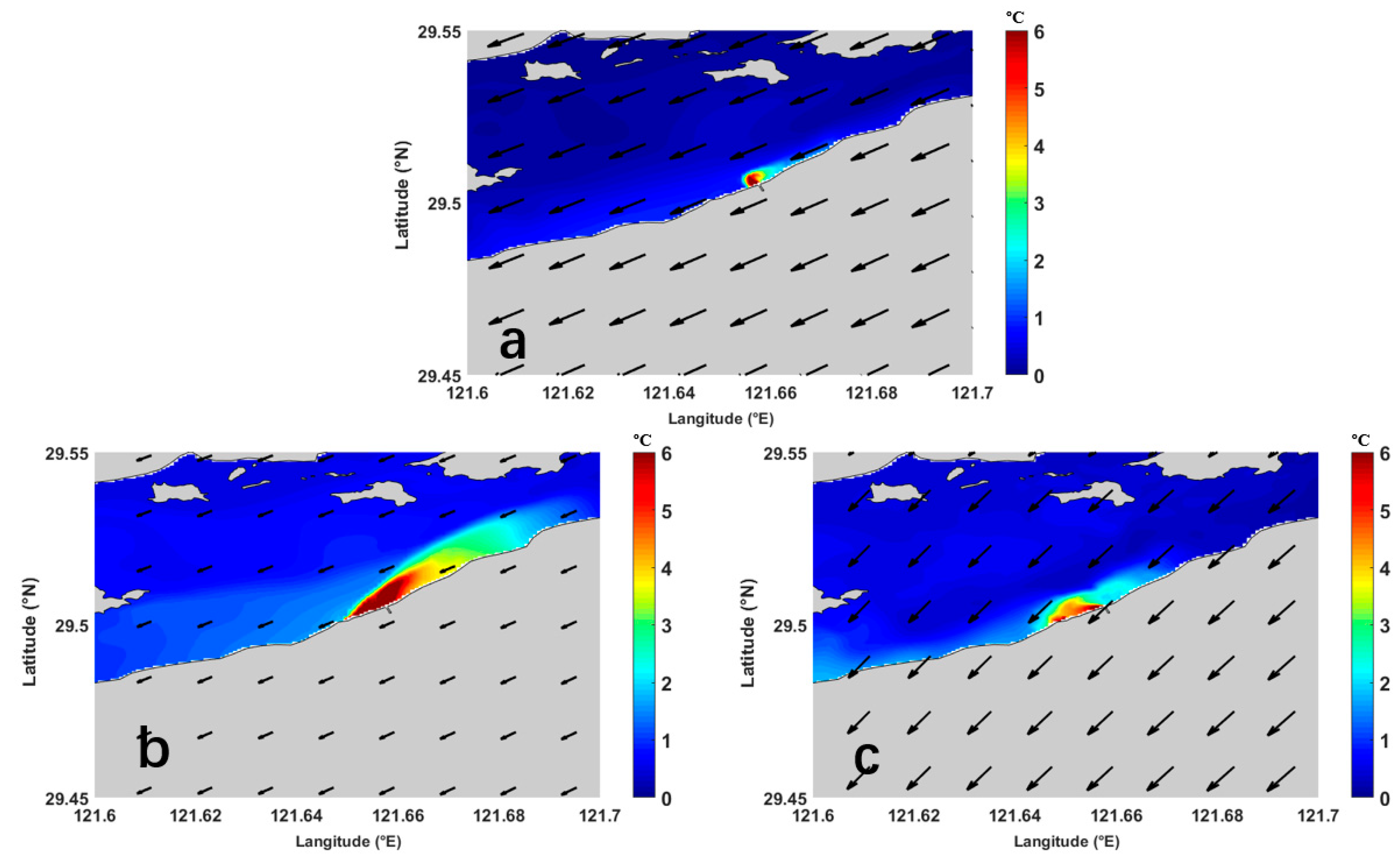

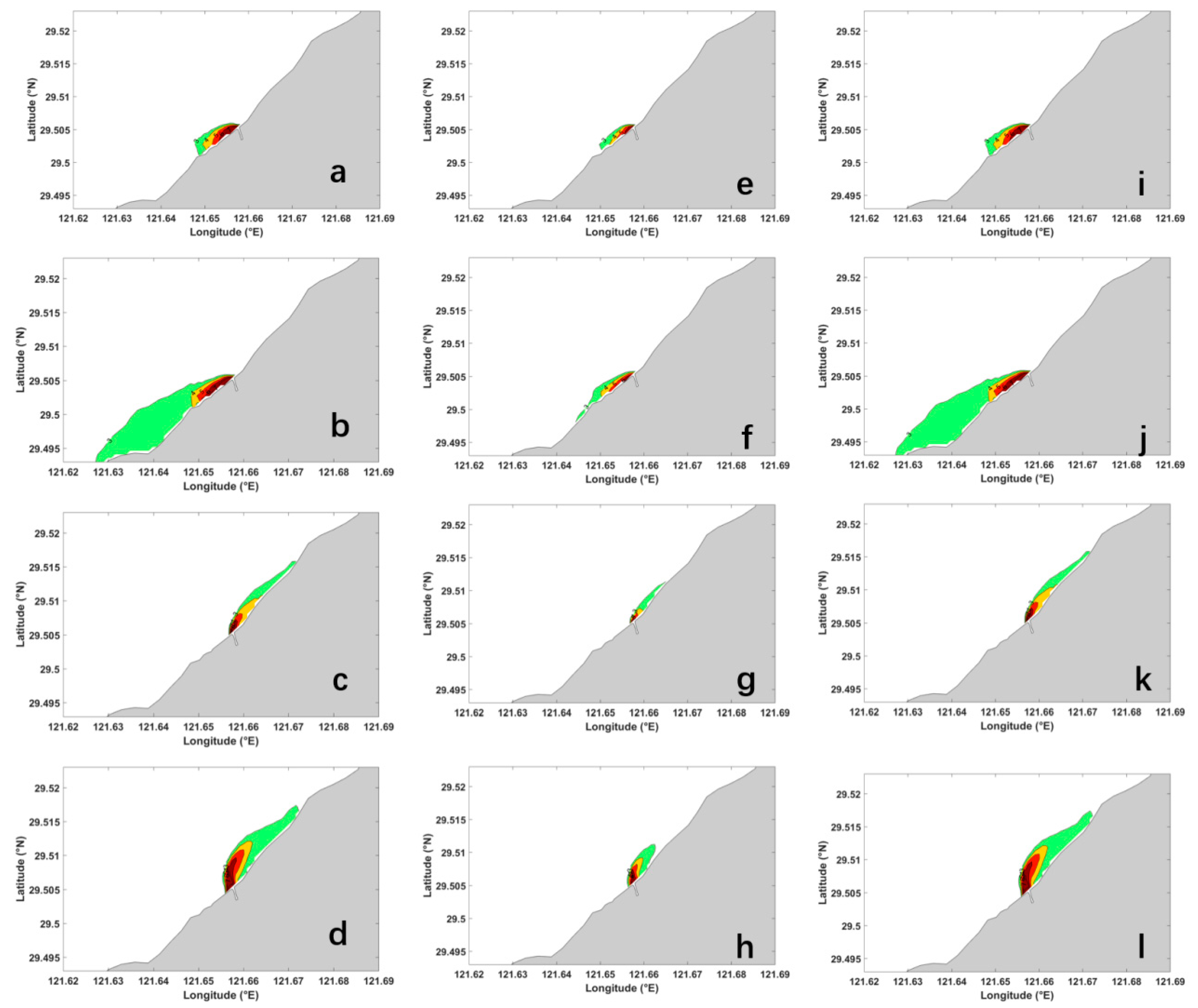
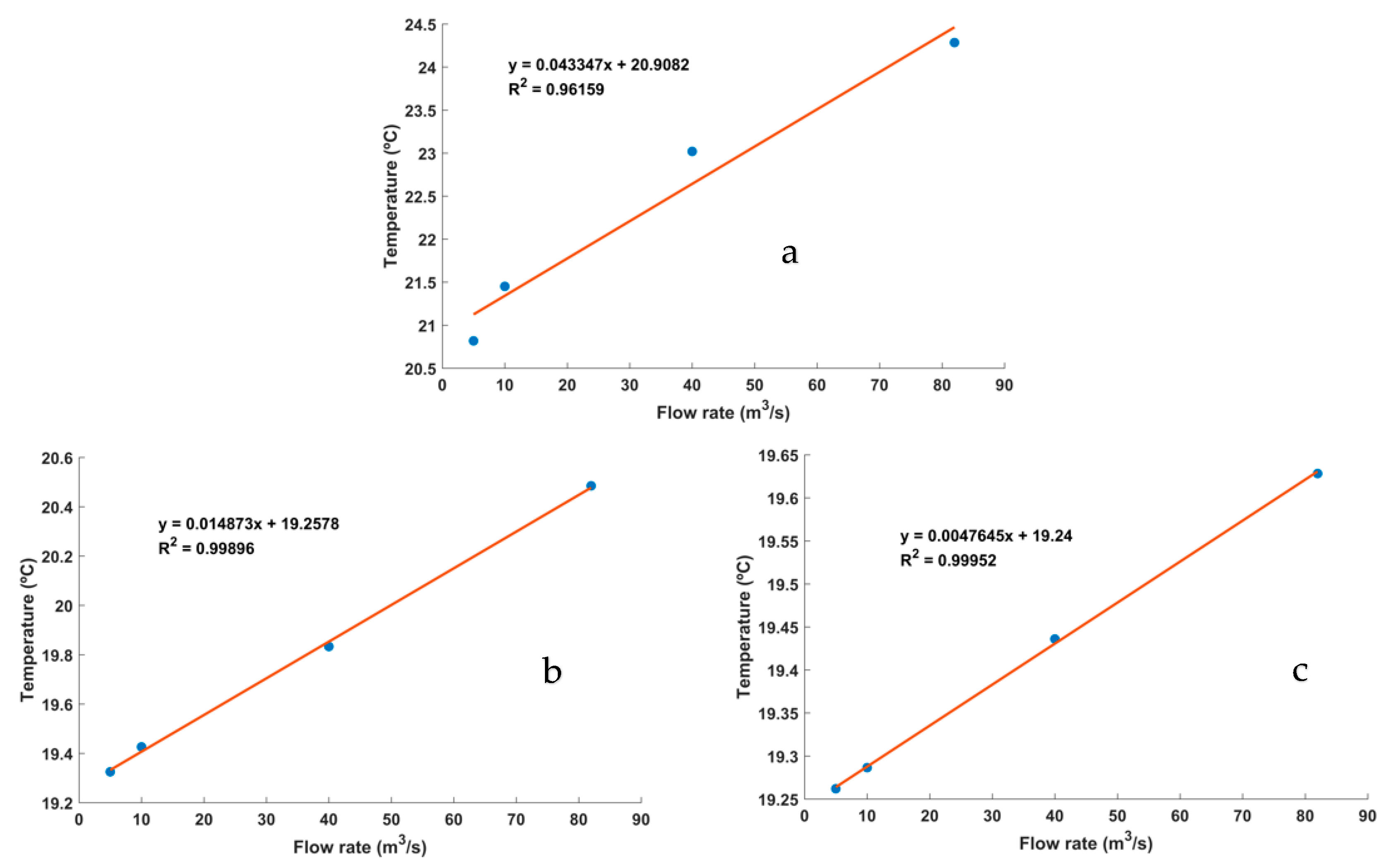
| Experimental Condition | Explanation |
|---|---|
| Exp1 | Considering the Wushashan Power Plant, the flow rate was set at 82.5 m3/s, taking into account the Coriolis force and surface discharge during calm weather. |
| Exp2 | On the basis of Exp1, but the flow rate of the power plant was halved. |
| Exp3 | On the basis of Exp1, but the influence of the Coriolis force was not considered. |
| Exp4 | On the basis of Exp1, but the thermal effluents were changed to bottom discharge. |
| Exp5 | Surface discharge, considering the Coriolis force, with a flow rate of 10 m3/s from the power plant. |
| Exp6 | Surface discharge, considering the Coriolis force, with a flow rate of 5 m3/s from the power plant. |
| Exp7 | On the basis of Exp1, but the thermal effluents were not considered. |
| Exp8 | The actual typhoon path and intensity of the Typhoon Lichima period, only considering the thermal discharge of Wushashan Power Plant. |
| Exp9 | Based on Exp8, but typhoon intensity was halved. |
| Exp10 | Based on Exp8, but the typhoon path moves north by 1 degree. |
| Exp11 | Based on Exp8, but does not consider thermal discharge. |
| Exp12 | Based on Exp8, but the intensity of typhoons is halved. Does not consider thermal discharge. |
| Exp13 | Based on Exp8, but the typhoon path moves north by 1 degree, and it does not consider thermal discharge. |
| Spreading Area (Unit: ×103 m2) | ||||
|---|---|---|---|---|
| Peak Flood | High Slack Water | Peak Ebb | Low Slack Water | |
| Exp1–Exp7 | 200.26 | 1005.67 | 261.13 | 602.81 |
| Exp2–Exp7 | 95.76 | 208.72 | 78.58 | 175.58 |
| Exp3–Exp7 | 199.98 | 1006.87 | 261.11 | 603.80 |
| Exp4–Exp7 | 120.94 | 621.43 | 311.44 | 632.08 |
| Exp5–Exp7 | 10.79 | 31.65 | 12.63 | 31.74 |
| Exp6–Exp7 | 4.06 | 13.67 | 3.96 | 13.24 |
Disclaimer/Publisher’s Note: The statements, opinions and data contained in all publications are solely those of the individual author(s) and contributor(s) and not of MDPI and/or the editor(s). MDPI and/or the editor(s) disclaim responsibility for any injury to people or property resulting from any ideas, methods, instructions or products referred to in the content. |
© 2024 by the authors. Licensee MDPI, Basel, Switzerland. This article is an open access article distributed under the terms and conditions of the Creative Commons Attribution (CC BY) license (https://creativecommons.org/licenses/by/4.0/).
Share and Cite
Kong, G.; Guan, W. Diffusion Characteristics and Mechanisms of Thermal Plumes from Coastal Power Plants: A Numerical Simulation Study. J. Mar. Sci. Eng. 2024, 12, 429. https://doi.org/10.3390/jmse12030429
Kong G, Guan W. Diffusion Characteristics and Mechanisms of Thermal Plumes from Coastal Power Plants: A Numerical Simulation Study. Journal of Marine Science and Engineering. 2024; 12(3):429. https://doi.org/10.3390/jmse12030429
Chicago/Turabian StyleKong, Gaoqiang, and Weibing Guan. 2024. "Diffusion Characteristics and Mechanisms of Thermal Plumes from Coastal Power Plants: A Numerical Simulation Study" Journal of Marine Science and Engineering 12, no. 3: 429. https://doi.org/10.3390/jmse12030429
APA StyleKong, G., & Guan, W. (2024). Diffusion Characteristics and Mechanisms of Thermal Plumes from Coastal Power Plants: A Numerical Simulation Study. Journal of Marine Science and Engineering, 12(3), 429. https://doi.org/10.3390/jmse12030429





